DIVE REPORT for BUNAKEN and MANADO TUA ISLAND
NORTH SULAWESI June 7-12, 2014
© 2014 Callyn Yorke
TABLE OF CONTENTS
________________________________________________________
The diving around Bunaken and Manado Tua Islands was phenomenal. Each dive site (see below) presented a novel combination of reefs and walls, providing habitat for countless organisms. The bathymetry of the area is remarkable in that there is no continental shelf, only precipitous drop-offs to the continental slope. Depths between Manado Tua Island (a dormant volcano) and neighboring Bunaken Island (presumably a sunken volcano) range approximately from 600 ft. to 5,500 ft.. Complex vertical and horizontal currents around these two islands distribute nutrients near the surface, supporting large schools of plankton-feeding fish, together with many other marine organisms in the food chain. The result is an unsurpassed marine biodiversity in waters with 30-90 ft. vertical visibility and surface temperatures of 78 to 82F.
I made a total of eleven dives between June 7-12, 2014, all but one (Muka Kampung) during the morning hours (0900-1200 hrs.). Nearly four years had passed since my most recent dive (Yucatan, Mexico), so I chose an option for a refresher dive course here at Bunaken Island. One of the young dive instructors working for the Living Colours Resort, Nils Langstredt, provided me with a brief refresher course at our first dive site, Muka Kampung. This involved a review of the basics, such as connecting the air tank to my bouyancy compensator vest (BC), testing the BC for inflation/deflation, testing the regulator and air quality, checking straps and weight belt, mask and fins. Nils used the phrase, “Breakfast with Rice and Fish” to help me remember the buddy-check safety procedure prior to entering the water. We also reviewed our immediate dive plan and a few hand signals (e.g. low on air, ascending, descending, etc.).
While maintaining neutral bouyancy a few feet below the surface, we practiced removing and replacing the regulator and mask. These last two emergency exercises were included with my original PADI open water certification course that I had completed in the Seychelles Islands in 1988. Much to my surprise, I had forgotten an important part of the procedure: When replacing a regulator in the mouth underwater, remember to clear the regulator first, either by pressing the air expulsion diaphragm or exhaling forcefully into the mouthpiece. If not, a small amount of seawater in the mouthpiece may be inhaled, causing mild discomfort (read: sending an inexperienced diver to the surface coughing and gasping for air).
After a few minutes of underwater practice with these fundamental safety exercises, I was ready to begin our first dive. Like any other sporting activity relying on life-saving equipment (e.g. sky-diving), the SCUBA experience is enhanced by a combination of competence and confidence in one’s ability to use the equipment properly. Except for occasional trouble equalizing the pressure in my eustachian tubes with the ambient pressure at depth, the next series of dives at Bunaken went pleasantly and without incident. I thank Nils and the rest of the staff at Living Colours for providing the necessary refresher dive course, which they had thoughtfully recommended when I arrived (see my photo of an emergency dive rescue on the Tengah wall, June 10, 2014).
The following is a chronological list of my dives, together with details regarding conditions, depth, time and organisms observed. Most of this report is based on my dive log notes made on the boat immediately following each dive. Subsequently, I used published and unpublished reference materials, including an undated publication by the North Sulawesi Watersports Association on the natural history of Bunaken National Park, by Arnaz Mehita. Comparing my underwater images (using an Olympus Stylus 1030 SW digital camera, waterproof PT-043 housing, and single Intova ISS 2000 Slave Flash), I relied heavily on many excellent photos and related natural history information found on the internet (e.g. Wikipedia) for identification and current taxonomy. Any mistakes regarding identification found in this report are entirely my own.
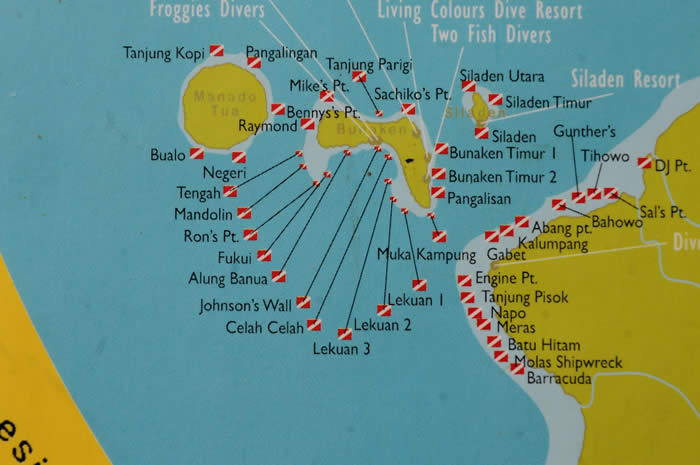
June 7, 2014 (one dive)
Dive Site: Muka Kampung – southern tip of Bunaken Island (see above map).
Time: 1500-1543 hrs.
Divers: Nils Langstredt, Mia Uutinen and I.
Maximum Depth: 42 ft.
Notes: We descended along a buoy line from a choppy, wind-blown surface; moderate (1-2 mph) horizontal current. A steep underwater slope with many vertical cracks and canyons. A varied coral reef with many types of sponges, corals and crinoids. Fishes noted included at least three species of boxfish (pufferfish), Moorish Idol, False Moorish Idol, about ten species of butterflyfish, sweetlips and one knifefish. One adult Green Sea Turtle was observed at a depth of about 30 ft. This was primarily an introductory dive with a refresher course at the outset. I did not have a camera for this dive.
June 8, 2014 (two dives)
Dive Site: Fukui – west coast of Bunaken Island (see above map).
Time: 0935-1015 hrs.
Divers: Nils Langstredt and I; several others from LC.
Maximum Depth: 74 ft.
Notes: A relatively calm surface; underwater current variable with depth (some drift) but generally weak. A slope nearly completely covered with foliose and branching hard corals; many large shelf-corals at depths of 20-30 ft. with branching and brain coral interspersed throughout. Some large barrel sponges and clams. Fish diversity relatively low compared with Muka Kampung. Highlights included, Yellow Pipefish (1 sp.), Red-breasted Wrasse (photo), Butterflyfish ( 5 spp), Angelfish (1 sp.), and many anemonefish (photos). One octopus was found beneath a rock overhang.
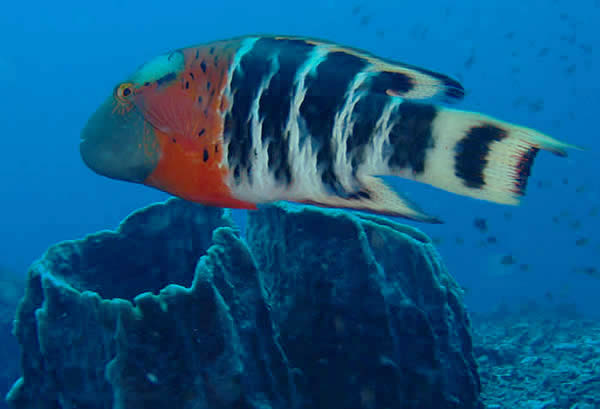
Dive Site: Mike’s Point – northwest coast of Bunaken Island (see map above)
Time: 1120-1200 hrs.
Divers: Nils and I; several others from LC.
Maximum Depth: 53 ft.
Notes: A relatively calm surface and variable underwater currents (5-10 mph), especially between 25 and 50 ft. The dominant topography is a vertical wall shaped like an amphitheatre with a shallow reef. This was by far the best dive site visited thus far around Bunaken Island, featuring many large brain corals, black corals and giant gorgonians. The coral gardens had many kinds of Ascidians (e.g. Solitary and Blue Tunicates) and sponges. Overall, this site appeared to support an extremely high diversity of fishes and invertebrates (photos). This was a classic drift-dive which, when concluded, left our group at least 700 ft. from our entry point. As a safety precaution, Nils inflated a signal buoy prior to our ascent. This procedure was always followed by the LC dive leaders.
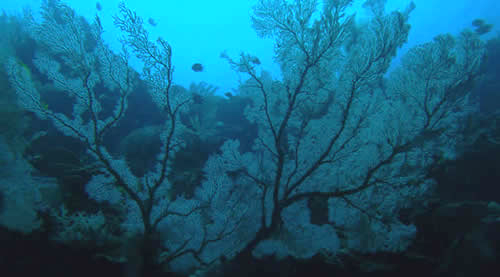
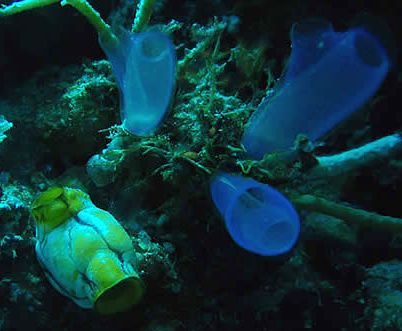
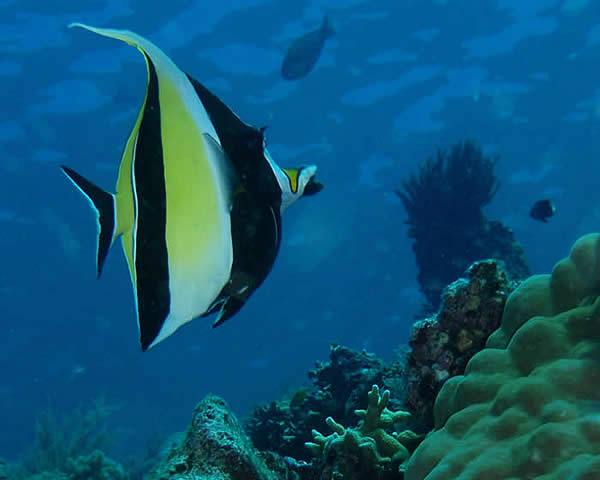
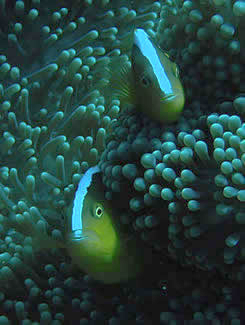
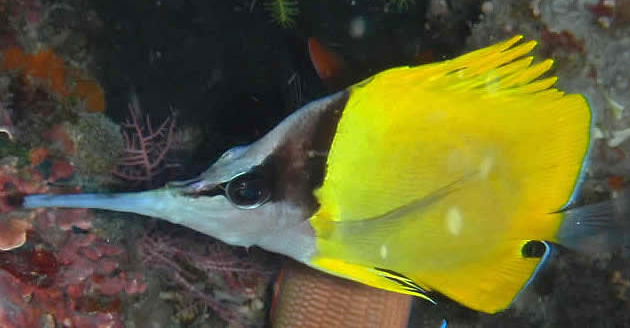
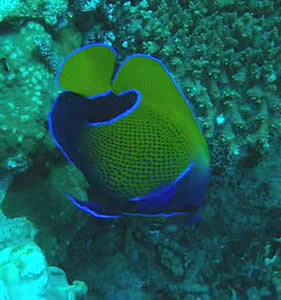
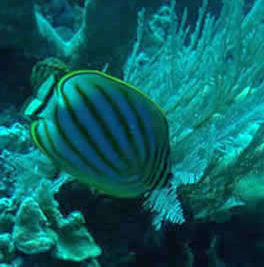
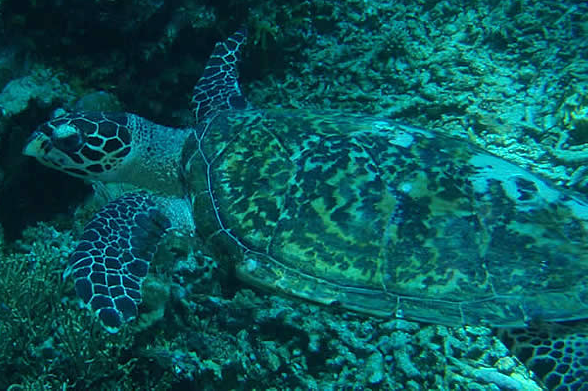
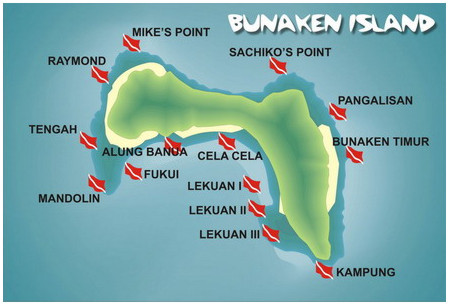
JUNE 9, 2014 (two dives)
DIVE SITE : Mandolin – west Bunaken (see map above)
Time: 0928-1010 hrs.
Maximum Depth: 62 ft.
Divers: Nils, Mia Uutinen and I; several others from LC.
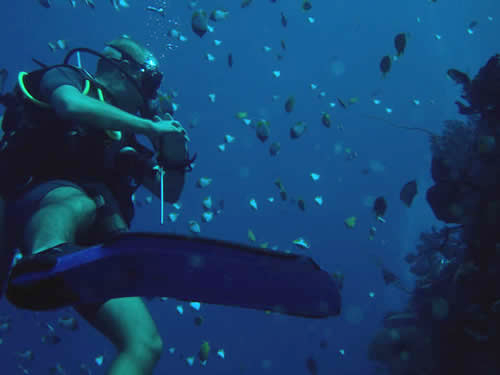
Notes: A sheer drop-off to about 180 ft. Excellent visibility, nearly to the bottom. Strong current (5-10 mph), resulting in difficulties positioning for photography; reflective particulates in the water column, as we drifted along the wall. Numerous large shelves on the wall with small caves below 40 ft. Exceptional coral diversity with many butterflyfish in schools, numerous Moorish Idol and damselfish. However, the overall fish diversity appeared lower than Mike’s Point. Many fish partially concealed in caves and crevices.
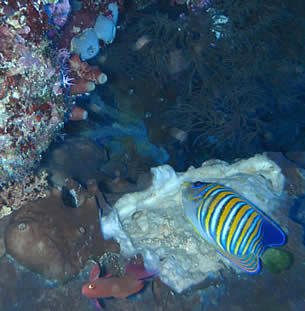
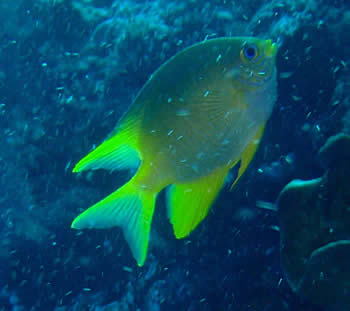
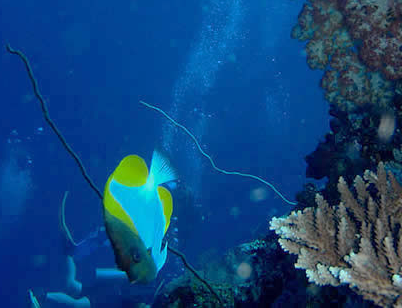
9 June 2014
DIVE SITE: Beruntun – southwest Bunaken, between Lekuan II and III (see preceeding maps)
Time: 1150-1250 hrs.
Maximum Depth: 63 ft.
Divers: Nils, Mia and I; several others from LC.
Notes: Another spectacular wall dive with noticably greater marine life diversity than Mandolin. Highlights of the dive included sightings of a White Nudibranch, Green Sea Turtle, Blue-spotted Ray, Surgeonfish, Blennies and Angelfish. The current was minimal, allowing for many photo opportunities.
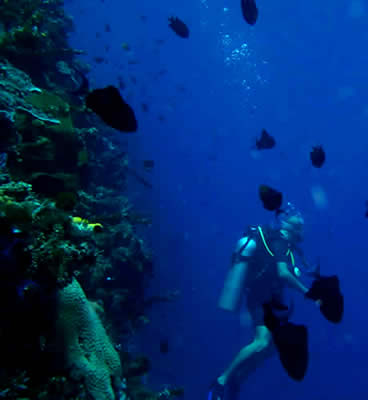
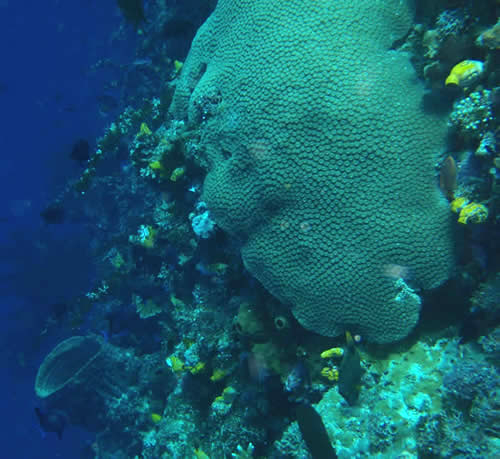
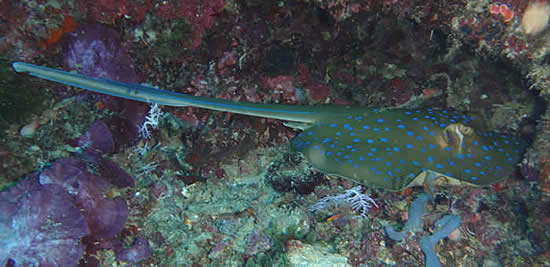
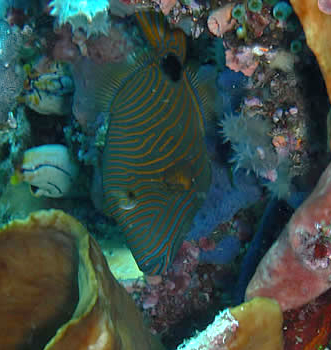
June 10, 2014 (two dives)
DIVE SITE: Negeri – South Manado Tua Island (see map above)
Time: 0930-1020 hrs.
Maximum Depth: 77 ft.
Divers: Mia Uutinen and I; several others from LC.
Notes: A sheer volcanic wall with many vertical cracks, canyons and small caves (some with lobsters). Reef top with diverse coral gardens (brain coral, branching coral and sponges). A moderately swift horizontal current with many schooling fish (e.g. Seargent Majors, damselfish, triggerfish and trumpetfish). An excellent site for photography.
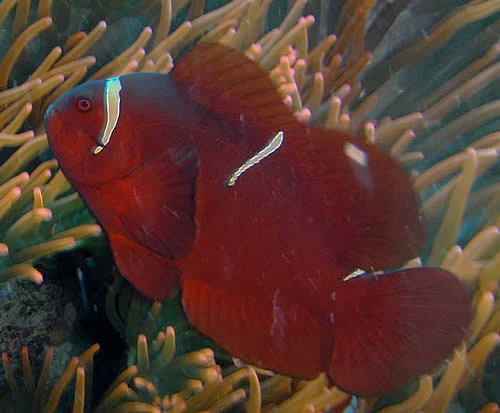
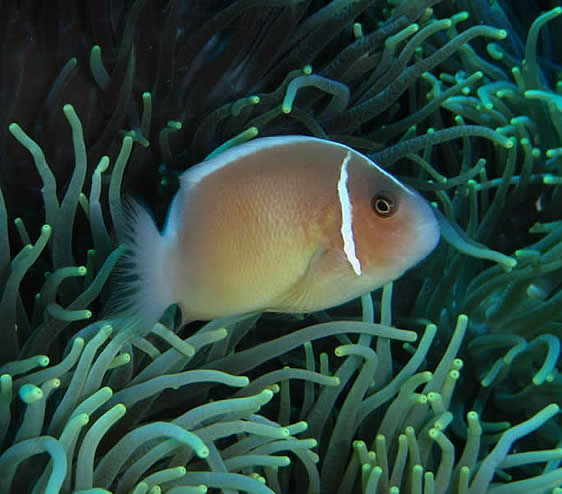
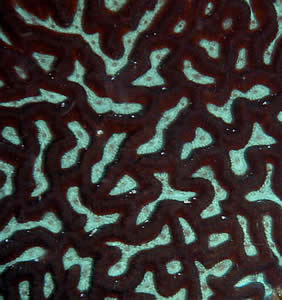
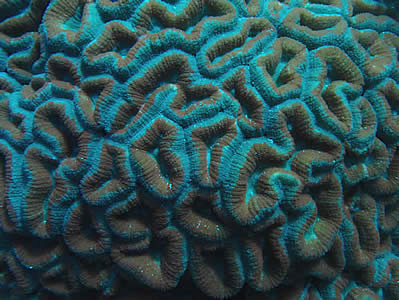
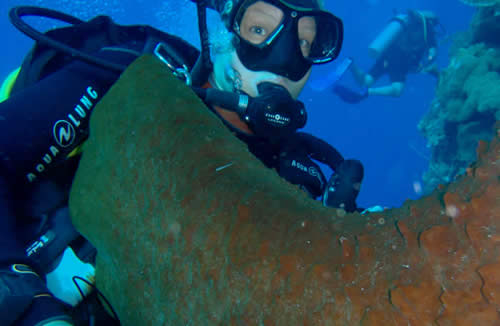
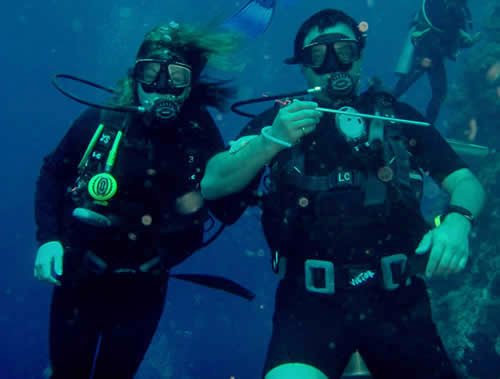
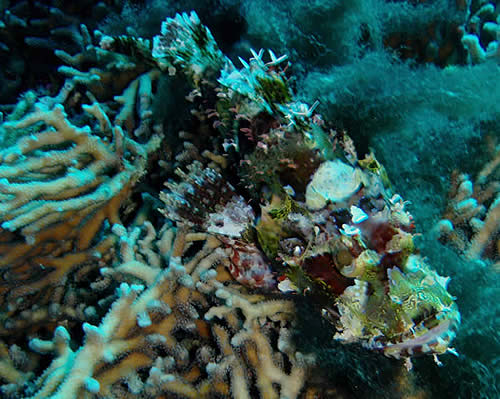
10 June 2014
DIVE SITE: Tengah – west Bunaken Island (see map above)
Time: 1200-1249 hrs.
Maximum Depth: 65 ft.
Divers: Mia and I; several others from LC.
Notes: Below a luxurient reef-top coral garden, we descended alongside a dramatic vertical wall, buffeted by increasingly strong horizontal and oblique currents (3-8 mph). We drifted along the wall beneath the reef, mostly between about 35 and 55 ft.. Large schools of triggerfish and an assortment of plankton-eaters followed us. Excellent visibility and many photo opportunities at this site. A diver in physiological distress was successfully rescued and slowly brought to the surface by two others in our group (photo).
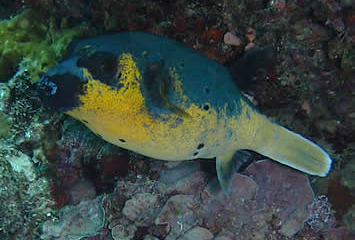
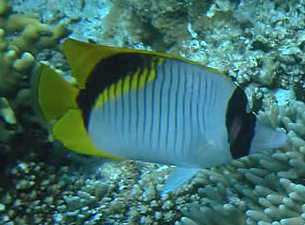
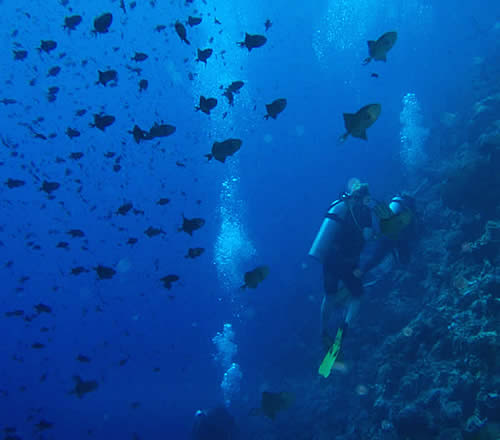
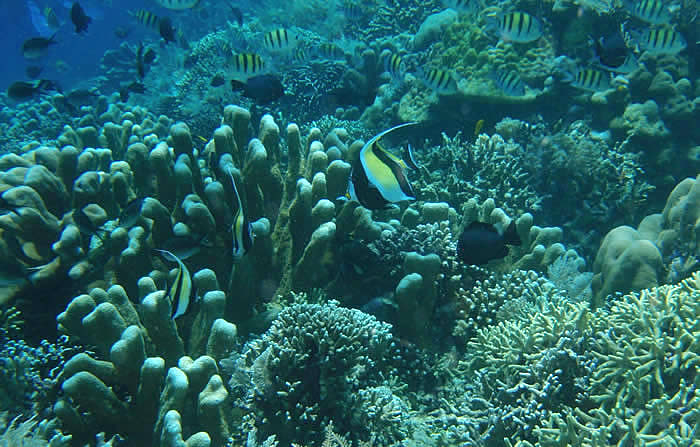
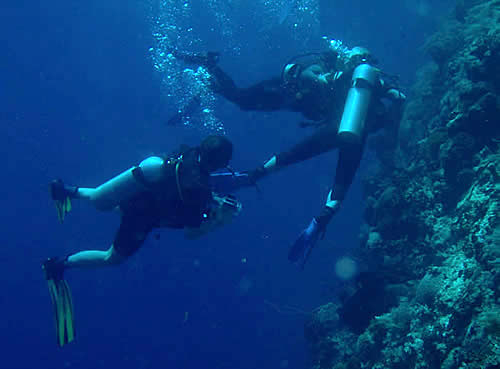
June 11, 2014 (two dives)
DIVE SITE: Sachiko’s Point – northeast Bunaken Island (see map above)
Time: 0925-1015 hrs.
Maximum Depth: 84 ft.
Divers: Mia Uutinen and I; several others from LC and Lorenzo Village, Bunaken Isle
Notes: An exceptionally rich coral reef community above 40 ft.. Large schools of Giant Trevally, Yellow-backed Fusilier (photo) and Pyramid Butterflyfish. Highlights also included, Emperor Angelfish, Regal Angelfish, Titan Triggerfish, Longfin Bannerfish, Emperor Parrotfish, Scrawled Filefish (photo), Pacific Trumpetfish (photo), fairy wrasse (photo), coronetfish, unicornfish and scorpionfish (photo). An adult Hawksbill Sea Turtle was also observed here. We descended a steep wall with excellent visibility, drifting with a mild horizontal current.
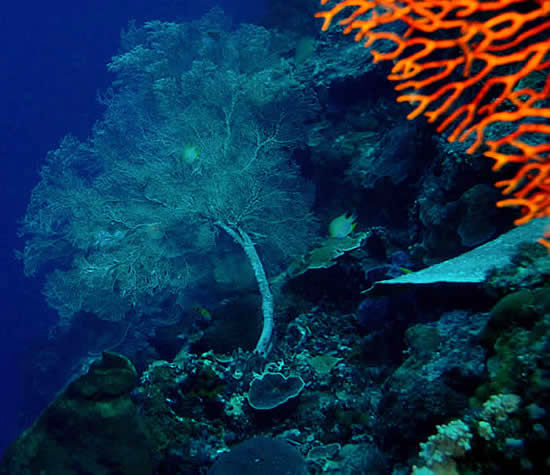
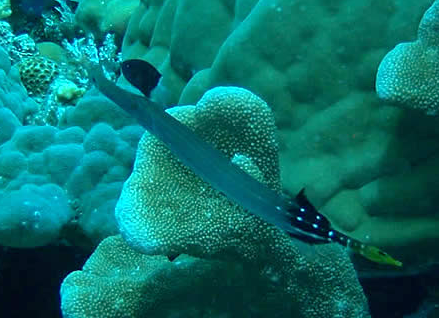
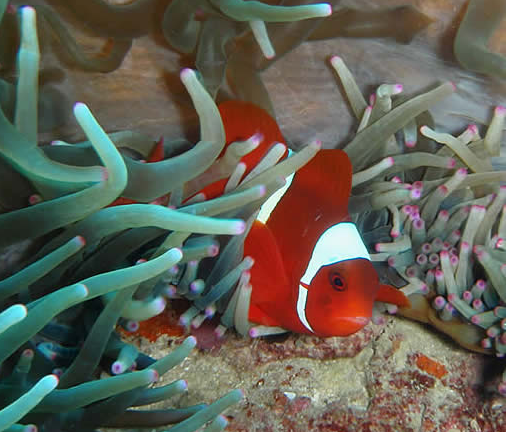
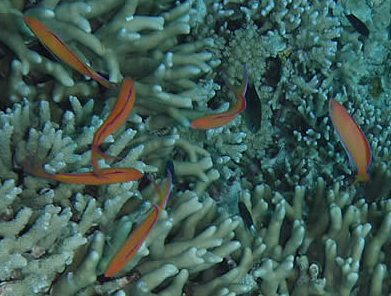
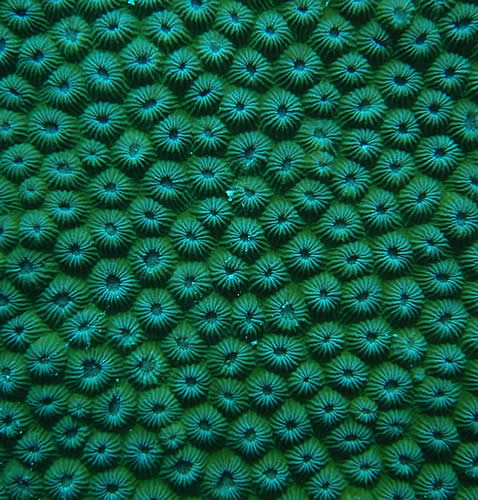
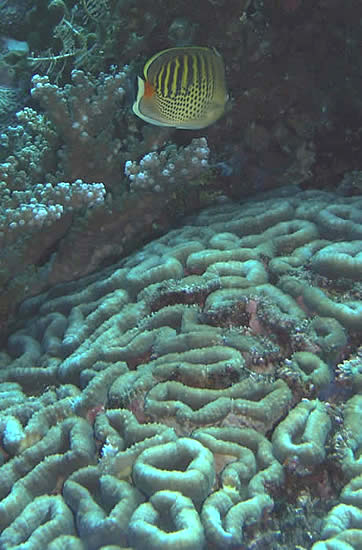
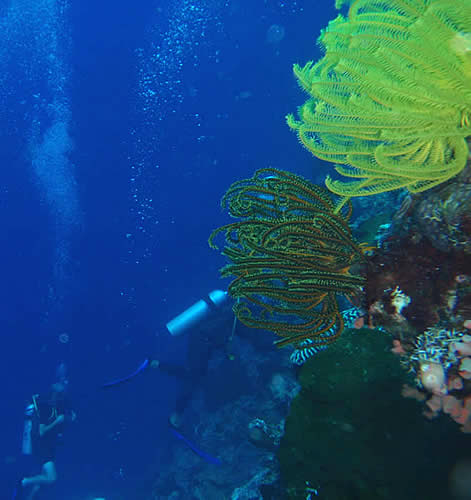
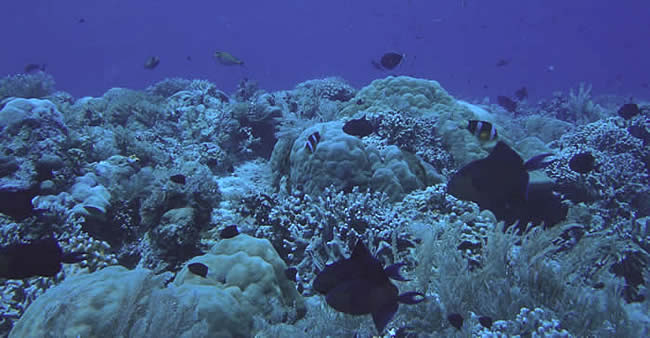
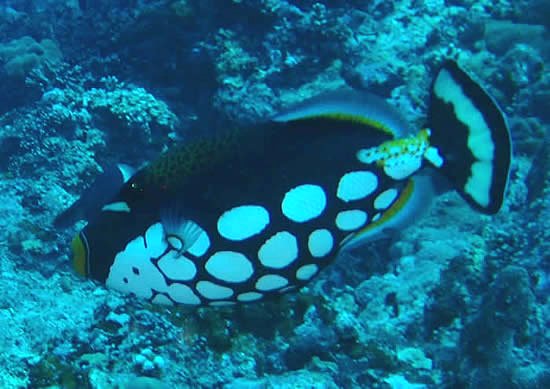
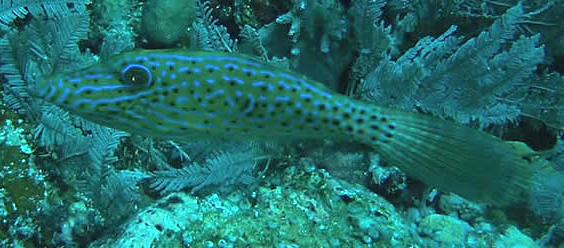
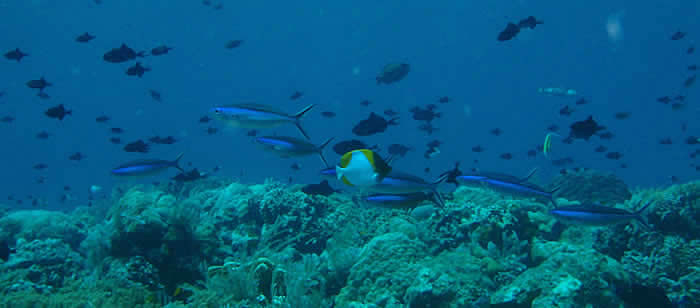
11 June 2014
DIVE SITE: Pangalingan – northeast Manado Tua Island
Time: 1200-1259 hrs.
Maximum Depth: 64 ft.
Divers: Mia Uutinen and I; several others from LC
Notes: A sandy slope with large rocks and coral formations, descending to a wall. Relatively mild currents. A good diversity of corals, crinoids; many of the same species of reef fish found at Sachiko’s Point. Highlights included, large schools of plankton-eating fish, a Black and Green Nudibranch (photo), a Blue-spotted Ray and another Hawksbill Sea Turtle.
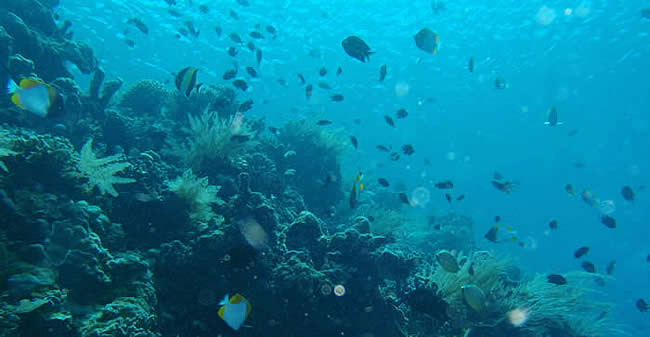
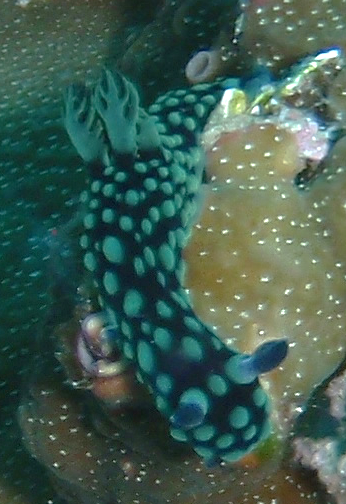
JUNE 12, 2014 (two dives)
DIVE SITE: Wori – coastline of Sulawesi adjacent to Bunaken Island (not shown on dive site maps).
Time: 0910-1005 hrs.
Maximum Depth: 63 ft.
Divers: Julie, Nils and I; several others from LC and another dive group.
Notes: This was a “Muck Dive,” and the only one of its kind I did on this trip. The bottom sediments were light-colored, loose silt and sand, easily disturbed by fin swimming action. There were many small burrows in the soft sediments with a variety of concealed and/or partly concealed creatures; scattered clumps of hard coral formations attracted a few types of reef fish (e.g. Anemonefish). Except for some unusual species, such as cuttlefish, nudibranchs and lionfish, the site had a low diversity of marine life compared with other dive sites around Bunaken and Manado Tua Islands.
Nevertheless, the animals we encountered here were largely new to my list for the Bunaken National Park area. Julie, an LC dive leader, did an excellent job hunting down and pointing out several interesting life forms. Photography was possible, though quite challenging, and largely limited to close-up flash work; particulates in the water column often disrupted the clarity of my images. Our boat ride from LC to this dive spot took about thirty minutes.
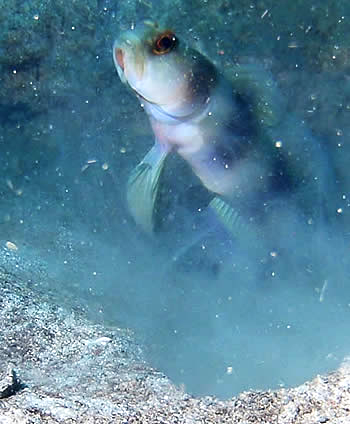
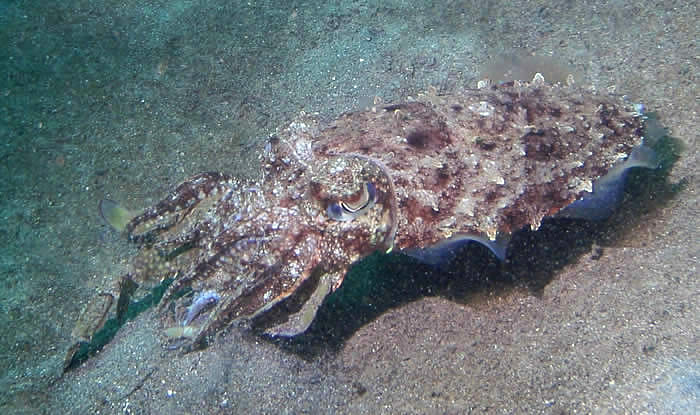
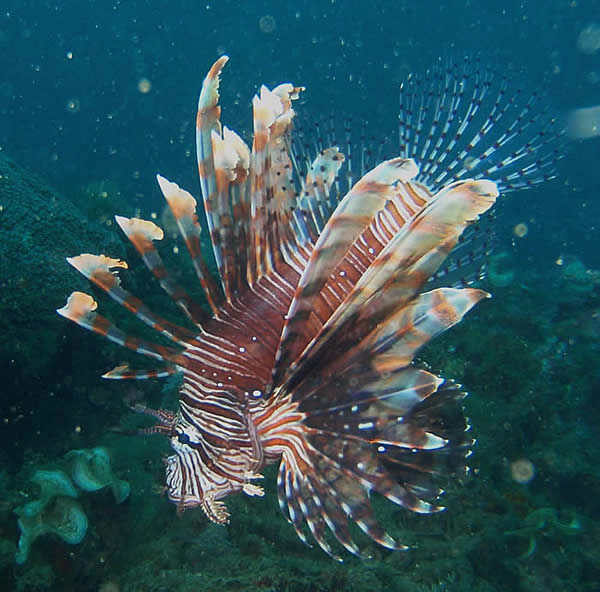
12 June 2014
DIVE SITE: House Reef – east Bunaken Island adjacent to the Living Colours Resort (see map above)
Time: 1130-1225 hrs.
Maximum Depth: 63 ft.
Divers: Julia, Nils and I; several others from LC.
Notes: Another spectacular reef and wall dive. Highlights included, Green Sea Turtle, Hawksbill Sea Turtle, Orangutan Crab, Titan Triggerfish, Sheephead, Unicornfish, Fire Goby, boxfish, and several new butterflyfish species (e.g. Spotfin, Black-striped) for my Bunaken dive trip list.
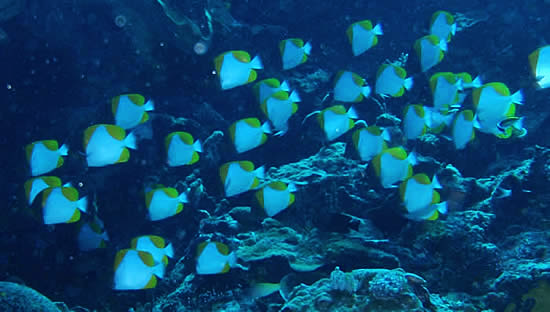
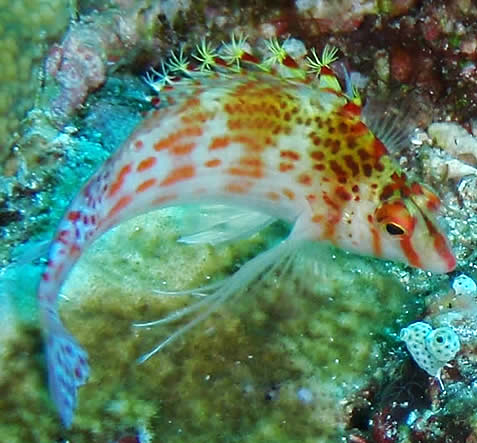
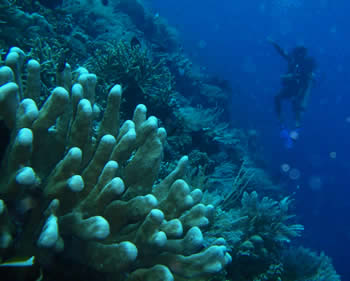
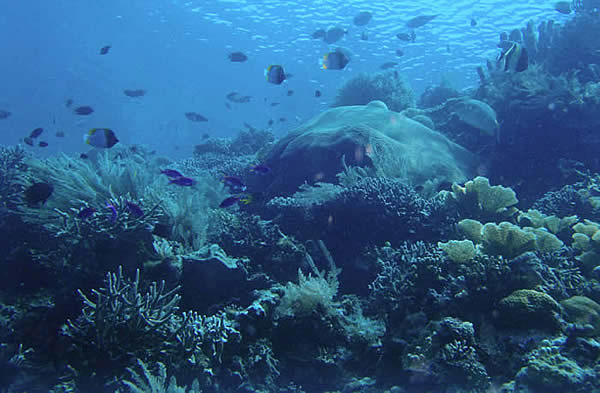
__________________________________________________